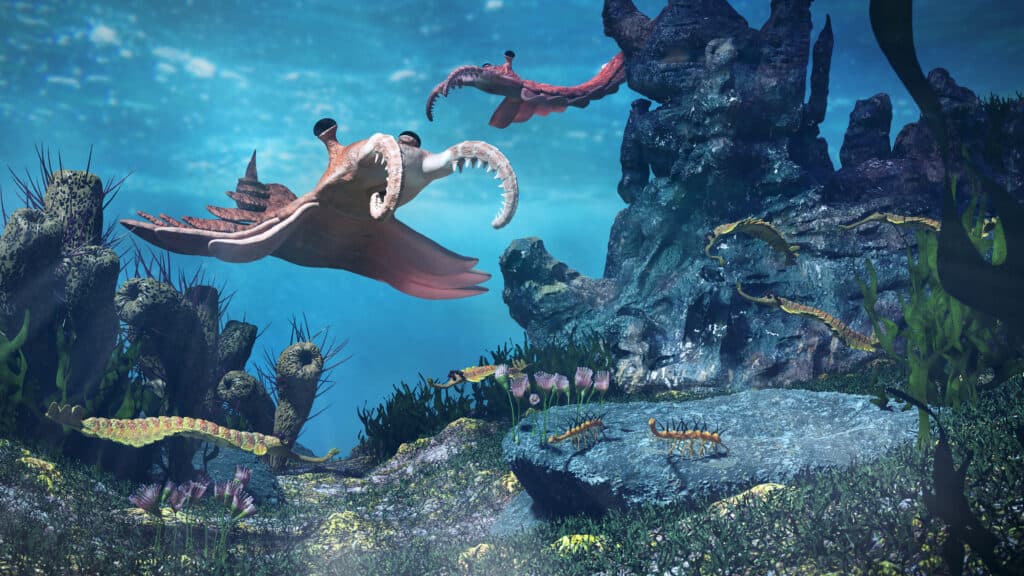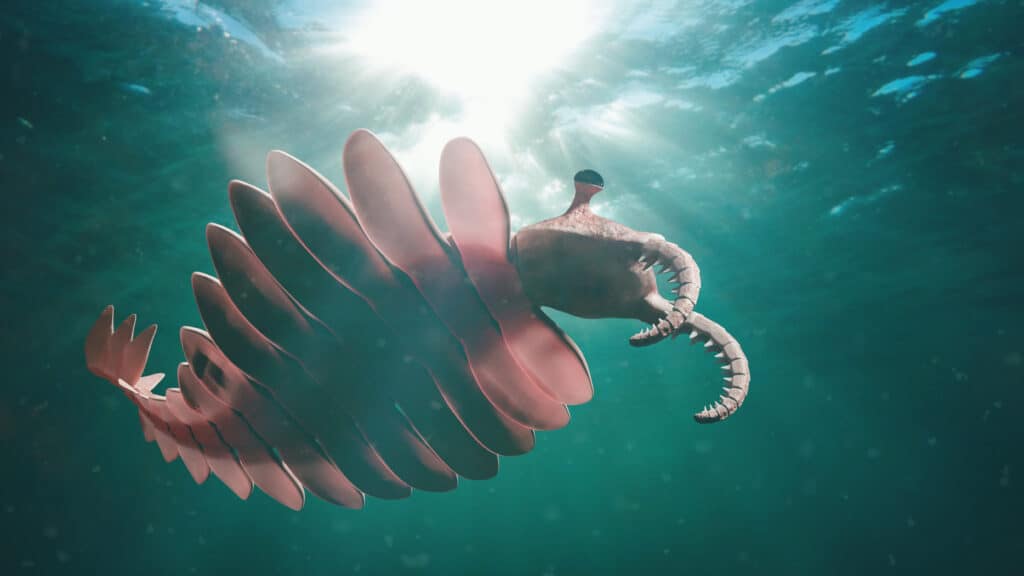The name Cambrian was derived from “Cambria,” the classical name for Wales. It was first used by Adam Sedgwick, a British geologist who lived in the 1800s. The period is the first geological period of the Paleozoic Era. It lasted for over 55 million years, from 541 million to 485.4 million years ago. It marked a crucial duration in the earth’s history because, according to fossil records, many kinds of vertebrates and invertebrate fishes appeared during the Cambrian era. Many scientists considered it the period when all life forms came into existence.
Scientists regard the Cambrian Period as the part of the Paleozoic Era that generated the most substantial evolutionary surge known to man. The Cambian Period contrasts with the Precambrian period, primarily characterized by a slow progression in evolution. A wide diversity of marine life emerged due to the Cambrian explosion. Often referred to as the biological big bang, the Cambrian explosion allowed life on earth to evolve from single-celled organisms to several new kingdoms and phyla. Many geologic and climatic events also occurred during this period.
Cambrian Period—Timeline
The Cambrian Period lasted for over 55 million years. It spread from the end of the Ediacaran Period to the beginning of the Ordovician. While some scientists contend that the total of the Cambrian Period was sixty million years, other estimates say it was between 53 and 55 million years. These years are divided into Early, Middle, and Late Cambrian. The subdivisions of the Cambrian Period are highlighted below:
- Early Cambrian: 538.8–509 million years ago.
- Middle Cambrian: 509–497 million years ago.
- Late Cambrian: 497–485.4 million years ago.
Major Events
The earth witnessed lots of changes during the Cambrian period. This included the appearance of new life forms, climate change, geology, continental rifts, and the mass extinction of a large percentage of several creatures.
Continental Dissolutions
Rodinia, a continent assembled a billion years before the Cambrian Period, fragmented into smaller continents shortly before the Cambrian began. This dissolution resulted in the creation of the Pacific Ocean. By Mid-Cambrian, the two major subcontinents formed from Rodinia, Laurentia, and Baltica, were wholly separated. At the same time, new collision events created Gondwana. This new supercontinent includes parts of present-day Antarctica, Australia, India, Africa, and South America. The drift resulted in crustal deformation and mountain building. Many major rock formations still visible today were formed during the Cambrian, making this period a significant one as far as earth’s geology is concerned.
The Cambrian Explosion of Life

Hallucigenia fossils have been found in the Burgess Shale deposits in southeastern British Columbia in Canada.
©Dotted Yeti/Shutterstock.com
Before the Cambrian, life on earth consisted mainly of single-celled organisms, a handful of multicellular organisms, and algae. The Cambrian Period ushered in an era of truly multicellular organisms. Animals with shells and exoskeletons appeared on earth for the first time during this period. They include mollusks, worms, sponges, echinoderms, trilobites, arthropods, and brachiopods. Scientists have varying theories to explain the sudden emergence of new lifeforms in geologic history.
Even if complex multicellular life existed before the Cambrian explosion occurred, they were in a form that made preservation difficult. During the Cambrian explosion, many of the animals that emerged had hard body parts, such as shells that could be preserved in rocks. Thus the fossil record as we know it today became only possible after the appearance of new lifeforms during the Cambrian period.
The closest similitude of plant life mainly consisted of colonies formed by several simplistic one-celled algae joined together. These were quite rampant during this period. The one-celled algae plants which formed big colonies like these were some of the most dominating plants of the Cambrian.
Cambrian Extinction
The Cambrian commenced with the explosion of all life forms and ended with a mass extinction. Glaciers lowered the temperatures of the shallow seas, which housed all of the planet’s new species. Alterations in temperatures and oxygen in the waters eliminated species that could not adapt quickly enough.
Rather than a single event, the disappearance of the lifeforms of the Cambrian took place in phases, with several minor extinction events occurring sporadically throughout the period. One of the earliest ones happened towards the middle of the Cambrian and may have been caused by receding seas. Scientists have identified at least three other events like this. Geochemical evidence suggests that these events were probably accompanied by sudden drops in water temperature.
The Cambrian Climate

Anomalocaris was a large, shrimp-like creature that lived during the Cambrian period.
©Dotted Yeti/Shutterstock.com
During the Cambrian, the earth’s temperature increased considerably. This changed the global ice age that preceded the period to more temperate conditions. Geologic records have shown that the Cambrian seas had elevated oxygen levels at that time due to algae. Since life forms were mainly confined to the oceans, scientists believe that more oxygen and temperatures contributed to the explosive diversity of life forms in the Cambrian. The Cambrian global climate was warmer than we now have in contemporary times. Still, it was more balanced throughout the plants. Unlike today, there were no glaciers at the planet’s poles.
Cambrian Marine Life
Marine life was plentiful during the Cambrian. The trilobites used to be the most abundant and diverse marine creatures during the Cambrian until scientific discovery proved trilobites were a minority compared to other arthropods. There are over 600 genera of Cambrian trilobites known to exist. Some trilobite species were the first to develop complicated eye structures.
Anomalocaris was the most fearsome predator in the Cambrian seas. Pikaia, the first known spinal-chord-bearing organism, was a wormlike creature that lived towards the middle of the Cambrian Period. Another strange but menacing creature was the five-eyed Opabinia. This creature caught its prey using a clawed arm attached to its head.
Other prominent marine life creatures include the archaeocyathids, brachiopods, pelecypods, and nautiloids. The jawless fishes also began to appear towards the end of this period. Despite being the minority, trilobites were some of the most enduring of all prehistoric animals. More than 17,000 trilobite species survived until the mega extinction of the Permian 251 million years ago.
Cambrian Terrestrial Life
Terrestrial life during the Cambrian Period was restricted and not as rich and diversified as its marine life. Complex life forms were non-existent, coupled with the fact that there were hardly any land plants. Their conspicuous absence subjected the limited Cambrian terrains to wind and water erosion.
There’s a slim possibility that a few Cambrian arthropods might have partially lived on land. But in the absence of fossil evidence, this belief is mostly speculation. Perhaps the most prominent form of life on land during the Cambrian was the stromatolitic growth of blue-green algae and bacteria that covered rocks.
Up Next
- Permian Period: Facts, Information, and Timeline
- Ordovician Period: Facts, Information, and Timeline
- Devonian Period: Facts, Information, and Timeline
The photo featured at the top of this post is © scigelova/Shutterstock.com
Sources
- National Park Service, Available here: https://www.nps.gov/articles/000/cambrian-period.htm
- National Geographic, Available here: https://www.nationalgeographic.com/science/article/cambrian
- Britannica, Available here: https://www.britannica.com/science/Cambrian-Period
- Berkeley , Available here: https://ucmp.berkeley.edu/cambrian/cambrian.php
Thank you for reading! Have some feedback for us? Contact the AZ Animals editorial team.






